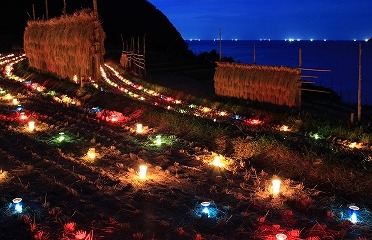Ogre and other characters run rampant in Obama Nakanata


Date: Last Sunday in September (The Sunday before October 2)
Location: Kamo 加茂, Obama city, Fukui Prefecture
Access: It takes about one hour from Kyoto to Tsuruga 敦賀 by express train. From there, change to the Obama Line and it takes about an hour to get to Shin Hirano 新平野.
Outline of Festival

http://nakanata.blogspot.com/2015/09/blog-post_27.html
The father of Japanese folklore says a festival was originally a simple way of worshipping a god. Eventually, when people came to travel to other areas and learned what was going on in other areas, they became more ingenious to make their own even better. He said they began to hold festivals more flamboyantly, more lavishly, and more lively. It is easy to imagine that many different types would have been created in such a process. And once an interesting one was created, the people around it would naturally copy it. In Japanese festivals, there is definitely a field of chasing and battling. It is mainly centered in western Japan, and can be found in Hiroshima, Osaka, and many other places. This was probably born as one of the models in such a flow. This is one of them. The festival is a very simple form. A small float in the form of a portable shrine on a car is pulled around and paraded through the town with people who play flute and drums (They are collectively called “Kagura” here).
At the shrine, girls perform an elegant traditional dance wishing for peace in the country. That’s it in a nutshell. There are no extravagant floats, and no fancy events. But that’s the way most festivals are held. Just what kind of characters will appear depends on the creativity of the district.
Characters
There are a total of four types that appear at this festival. “The demon called “yase,” the hyottoko, the okame, and the choroken. “Hyottoko” and “Okame” are two of the most popular festival characters. They entertain people with their comical movements. (For more information, please see
The word “yase” is a corruption of “yasha.” Yasha is an Indian deity and one of the guardian deities in Buddhism. In this “Yasha” group is “Kishimojin”. In order to feed her own children, Kishimojin kidnaps many human children and feeds them to her children. When the Buddha saw this, he hid her child and made her realize how sad it was to lose a child. The story goes that since then she has become the goddess of children and safe childbirth. In this festival, he appears as a red and blue masked demon, holding a long stick. They chase and beat children who make fun of them. They are almost always drunk, so even if you hit them lightly, they feel a lot of pain. But when they visit nurseries and kindergartens, everyone is scared when they come, but after they leave, everyone wants to play “Yase” games.
“Choroken” is the most popular character in this festival. “Choroken is an art form that emerged in the latter half of the Edo period (the samurai government under the Tokugawa shogun). During the New Year’s holidays, the performers would go door to door to perform their art and receive congratulatory gifts. After the end of the samurai government and the beginning of a new era, people turned a blind eye to them, saying that their antics were not appropriate for the new era, and they eventually disappeared around the time of the approaching war. It was a regional art form, mainly in Osaka and Kyoto. Here he appears in a red hat, red clothes, and a tengu-like mask.
They begin to go through the town with the portable shrine on tall casters from 10 am to 3 pm. At last, they perform at the shrine.


Around this area
There are also scenic spots and old townscapes (designated by the government as a preservation area) in the vicinity. There is a quiet, unspoiled Japan that is not often visited. A little further away (about 15 kilometers), there are beautiful terraced rice fields that are lit up during the festival season. It is definitely worth a visit.







